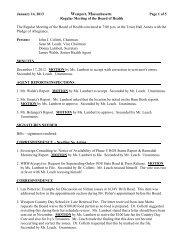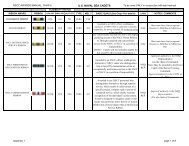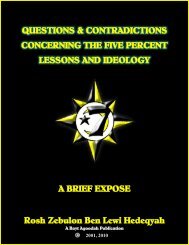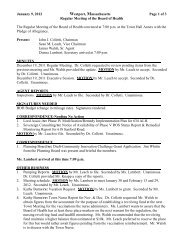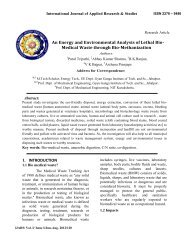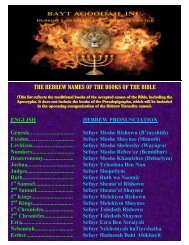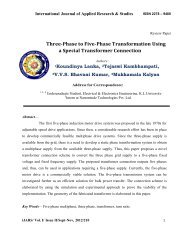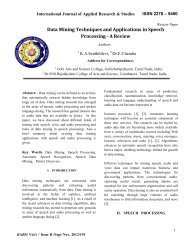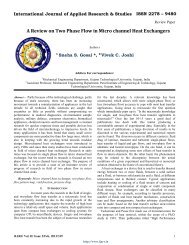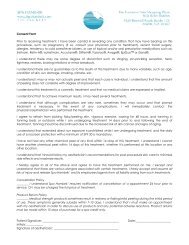A Review of Neem Biodiesel As Fuel for CI Engine - Hgsitebuilder ...
A Review of Neem Biodiesel As Fuel for CI Engine - Hgsitebuilder ...
A Review of Neem Biodiesel As Fuel for CI Engine - Hgsitebuilder ...
Create successful ePaper yourself
Turn your PDF publications into a flip-book with our unique Google optimized e-Paper software.
International Journal <strong>of</strong> Applied Research & Studies ISSN 2278 – 9480<br />
Nitrogen oxides (Nox)<br />
10<br />
8<br />
6<br />
4<br />
2<br />
0<br />
DIESEL<br />
B05<br />
B20<br />
Atul Dhar<br />
et. al[11]<br />
R.Senthilkumar<br />
et al[12]<br />
Nishant Tyagi<br />
et. al[13]<br />
FIGURE .6: VARIATION IN OXIDES OF NITROGEN FOR DIFFERENT<br />
FUEL<br />
Hydrocabon (HC)<br />
Atul Dhar et. al [11] evaluated that emissions <strong>of</strong><br />
hydrocarbon is 35.7 % decrease with blends <strong>of</strong> 20%<br />
neem biodiesel and 80 % diesel. They found 70<br />
gm/kwhr with pure diesel, 45 gm/kwhr with blend<br />
20% neem biodiesel and 80% diesel, 50 gm/kwhr with<br />
blend 100% neem biodiesel. They found that all<br />
biodiesel blends exhibit lower the HC emission<br />
compared to mineral diesel this may be due to<br />
combustion <strong>of</strong> biodiesel blends due to presence <strong>of</strong><br />
oxygen. R. Senthilkumar et al [12] investigated that<br />
emissions <strong>of</strong> hydrocarbons is 36% lower <strong>for</strong> blend <strong>of</strong><br />
20 % neem biodiesel and 80 % diesel. They found 50<br />
gm/kwhr with pure diesel, 35 gm/kwhr with blend<br />
20% neem biodiesel and 80% diesel. Compare to pure<br />
diesel they attributed that the less emission compare to<br />
diesel due to good mixture <strong>for</strong>mation.<br />
Hydrocabon (HC)<br />
80<br />
60<br />
40<br />
20<br />
0<br />
Atul Dhar<br />
et. al[11]<br />
R.Senthilkumar<br />
et al[12]<br />
DIESEL<br />
B100<br />
B30<br />
B20<br />
Nishant Tyagi<br />
et. al[13]<br />
gm/kwhr with blend 20% neem biodiesel and 80%<br />
diesel. For B10 and B20 percentage <strong>of</strong> hydrocarbons<br />
decreases because <strong>of</strong> better combustion which may be<br />
attributed to extra oxygen present in they blend but <strong>for</strong><br />
B20 the percentage <strong>of</strong> hydrocarbons increases slightly<br />
due to insufficient combustion because <strong>of</strong> higher<br />
viscosity which may lead to poor mixture <strong>for</strong>mation<br />
due to poor atomization.<br />
References:<br />
[1] Dr. Archana S., “Basic Statistics on Indian Petroleum &<br />
Natural Gas 2009-10” October 2010.<br />
http://petroleum.nic.in/petstat.pdf<br />
[2] Dr. N. K. Giri, Automobile Technology, 1st Edition, Khanna<br />
Publisher, 2008, pp 223-262<br />
[3] Dr. S. S. Thipse, Internal Combustion <strong>Engine</strong>, 2nd Edition,<br />
Jaico Publishing House, 2008, pp 461-480<br />
[4] Dr. Tiwari, “Report <strong>of</strong> Committee on Development <strong>of</strong> Bi<strong>of</strong>uel<br />
Planning commission <strong>of</strong> India”, April 2003,<br />
http://planningcommission.nic.in/reports/genrep/cmtt_bio.pdf<br />
[5] H. Raheman and S. V. Ghadge, “Per<strong>for</strong>mance <strong>of</strong> Compression<br />
Ignition <strong>Engine</strong> with Mahua(Madhuca Indica) Bio-diesel”,<br />
<strong>Fuel</strong> 86, March 2007, pp: 2568-2573<br />
[6] Herath Gunatilake, “Economy-Wide Impacts <strong>of</strong> Bio-diesel<br />
Production and Use in India: A Computable General<br />
Equilibrium”, May 2011<br />
http://www.adb.org/Documents/Papers/South-<strong>As</strong>ia-Working-<br />
Paper-<br />
Series/Economy-Wide-Impacts-Bio-diesel-<br />
Production.pdf<br />
[7] Anindita Karmakar,Subrata Karmakar ,Souti Mukherjee<br />
“<strong>Biodiesel</strong> production from neem towards feedstock<br />
diversification : Indian perspective”,Renewable and<br />
Sustainable Energy <strong>Review</strong>s 16 (2012) 1050 1060D1<br />
[8] Pravin A. Manade, Dr. Pr<strong>of</strong>. <strong>As</strong>hok T. Pise, Sandesh Cougule<br />
“Properties <strong>of</strong> Bi<strong>of</strong>uels and their Diesel Blends as a <strong>Fuel</strong> <strong>for</strong><br />
C.I. <strong>Engine</strong>s” IEEE-International Conference ON Advance In<br />
<strong>Engine</strong>ering,Science And Management (ICAESM-2012)<br />
March 30,31,2012, pp: 255 -262.<br />
[9] Rajit S., Ph. D. Thesis, “Process Standardization,<br />
Characterization and Experimental Investigation on the<br />
Per<strong>for</strong>mance <strong>of</strong> Bio-diesel <strong>Fuel</strong>led <strong>CI</strong> <strong>Engine</strong>” Thapar<br />
University, 2011<br />
[10] Saroj K. Padhi and R. K. Singh, “Non-edible oils as the<br />
potential source <strong>for</strong> the production <strong>of</strong> bio-diesel in India: A<br />
review”, Journal <strong>of</strong> Chemical and Pharmaceutical Research,<br />
2011, pp: 39-49<br />
[11] Atul Dhar, Roblet Kevin, Avinash Kumar Agarwal “<br />
Production <strong>of</strong> biodiesel from high –FFA neem oil and its<br />
per<strong>for</strong>mance, emission and combustion characterization in a<br />
single cylinder DI<strong>CI</strong> engine”. <strong>Fuel</strong> Processing Technology 97<br />
(2012) 118-129<br />
[12] R. Senthilkumar, K. Ramadoss, M. Prabhu “Emission and<br />
Per<strong>for</strong>mance Characteristics <strong>of</strong> Single Cylinder Diesel <strong>Engine</strong><br />
<strong>Fuel</strong>led With <strong>Neem</strong> <strong>Biodiesel</strong>” IEEE-International<br />
Conference On Advance In <strong>Engine</strong>ering,Science And<br />
Management (ICAESM-2012) March 30,31,2012, pp: 353-<br />
359.<br />
[13] Nishant Tyagi, Ambuj Sharma “Experimental Investigation <strong>of</strong><br />
<strong>Neem</strong> Methyl Esters <strong>As</strong> Biodisel on C.I. <strong>Engine</strong>” International<br />
Journal <strong>of</strong> <strong>Engine</strong>ering Research and Aplication” ISSN: 2248-<br />
9622, Vol. 2, Issue 4, July-August 2012, pp. 1673-1679<br />
FIGURE .7: VARIATION IN HYDROCABON FOR DIFFERENT FUEL<br />
Nishant Tyagi et al [13] experimentally found that<br />
hydrocarbon emission is 24.24% lower <strong>for</strong> blends <strong>of</strong><br />
20% neem biodiesel and 80 % diesel compare to pure<br />
diesel They found 33 gm/kwhr with pure diesel, 25<br />
krunal12345@rediffmail.com * Corresponding Author Email-Id<br />
iJARS/ Vol. II/ Issue I/Jan, 2013/290 6<br />
http://www.ijars.in





